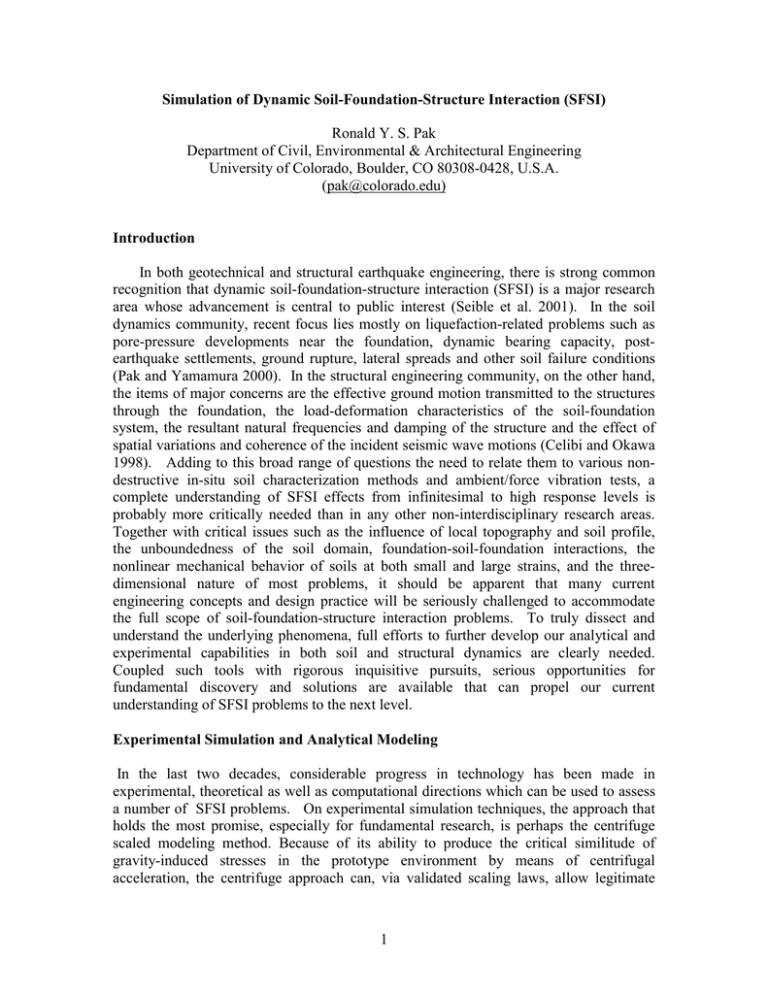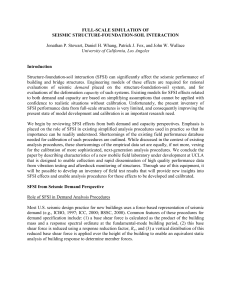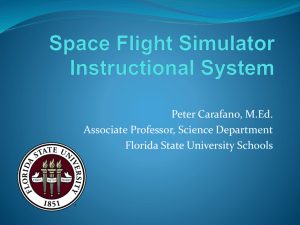Ronald Y. S. Pak Department of Civil, Environmental & Architectural Engineering
advertisement

Simulation of Dynamic Soil-Foundation-Structure Interaction (SFSI) Ronald Y. S. Pak Department of Civil, Environmental & Architectural Engineering University of Colorado, Boulder, CO 80308-0428, U.S.A. (pak@colorado.edu) Introduction In both geotechnical and structural earthquake engineering, there is strong common recognition that dynamic soil-foundation-structure interaction (SFSI) is a major research area whose advancement is central to public interest (Seible et al. 2001). In the soil dynamics community, recent focus lies mostly on liquefaction-related problems such as pore-pressure developments near the foundation, dynamic bearing capacity, postearthquake settlements, ground rupture, lateral spreads and other soil failure conditions (Pak and Yamamura 2000). In the structural engineering community, on the other hand, the items of major concerns are the effective ground motion transmitted to the structures through the foundation, the load-deformation characteristics of the soil-foundation system, the resultant natural frequencies and damping of the structure and the effect of spatial variations and coherence of the incident seismic wave motions (Celibi and Okawa 1998). Adding to this broad range of questions the need to relate them to various nondestructive in-situ soil characterization methods and ambient/force vibration tests, a complete understanding of SFSI effects from infinitesimal to high response levels is probably more critically needed than in any other non-interdisciplinary research areas. Together with critical issues such as the influence of local topography and soil profile, the unboundedness of the soil domain, foundation-soil-foundation interactions, the nonlinear mechanical behavior of soils at both small and large strains, and the threedimensional nature of most problems, it should be apparent that many current engineering concepts and design practice will be seriously challenged to accommodate the full scope of soil-foundation-structure interaction problems. To truly dissect and understand the underlying phenomena, full efforts to further develop our analytical and experimental capabilities in both soil and structural dynamics are clearly needed. Coupled such tools with rigorous inquisitive pursuits, serious opportunities for fundamental discovery and solutions are available that can propel our current understanding of SFSI problems to the next level. Experimental Simulation and Analytical Modeling In the last two decades, considerable progress in technology has been made in experimental, theoretical as well as computational directions which can be used to assess a number of SFSI problems. On experimental simulation techniques, the approach that holds the most promise, especially for fundamental research, is perhaps the centrifuge scaled modeling method. Because of its ability to produce the critical similitude of gravity-induced stresses in the prototype environment by means of centrifugal acceleration, the centrifuge approach can, via validated scaling laws, allow legitimate 1 extrapolation of model response to full-scaled situations. Owing to the efficiency gained in small-scale model testing, many tests can be performed at a fraction of the cost of a corresponding full-scale test program even if the latter were technically feasible. The result is a significant improvement in the confidence of the test data which can and should always be repeated for more resolution and checked for consistency. For a number of SFSI problems, not only have the necessary centrifuge simulation technologies been developed (e.g. 1D shakers, laminar boxes, viscously damped containers, half-space simulation methodologies), their usage have generated some serious new insights which have altered the current interpretation of a number of SFSI problems (e.g., Pak and Ashlock 2000). While more innovative developments are still needed to simulate a number of important SFSI phenomena on a centrifuge, the scaled modeling approach is certain to be a critical tool that can help bring the subject to the next level of scientific understanding and comprehension. On the theoretical and computational side, the power of continuum mechanics in the context of viscoelastic and elastoplastic constitutive theories is now within an engineer’s reach by virtue of numerical methods such as finite element and boundary element analysis. While their direct relevance and reliability as the basis of engineering design can at times be legitimately challenged as do experimental methods, the conceptual exercise generated by analytical methods, especially if coupled with experimental research, is often a prerequisite to sorting out the underlying structure of a complex problem. As illustrations of the virtue of such a combined approach, a brief report will be given on some insights gained from a series of integrated experimental and analytical investigations on a class of basic dynamic SFSI problems. While they will serve well to highlight the complexities of even the simplest of SFSI problems, these observations also outline a path of great opportunities for the construction of a more effective framework beyond those used in the last century. Some Physical and Analytical Observations To explore the fundamental aspects of dynamic SFSI problems, a systematic research program of dynamic scaled modeling has been ongoing at the University of Colorado, Boulder using its large 400 g-ton geotechnical centrifuge. By means of a set of effective half-space simulation methodologies (see Pak and Guzina 1994), complete frequencydomain characterizations of the dynamic characteristics of a variety of foundations under multi-directional forced vibration have been proven to be feasible. Comparing such data on granular soils with some of the popular theoretical models for instance, there are a number of observations which could be of immediate interest and practical relevance even without any advanced synthesis: (1) Effect of foundation size and contact pressure: From the data base, it has been consistently found that the static foundation contact stress level has a major influence on the dynamic response of the soil-structure system. No only does it affect the foundation impedance sensitively, it also moderates the degree of nonlinearity in the response with respect to the dynamic excitation level. From the experimental results, it was also found that the foundation dimension is an important parameter to the foundation stiffness as well as its overall response. 2 (2) Mode of vibration From a comparison of the experimental data with the commonly-used homogeneous halfspace theoretical solution, it was found that the theory cannot describe concurrently all modes of structure-foundation motion as observed in the physical tests. While the vertical vibration mode can be handled by the mathematical solution by means of the concept of an equivalent homogeneous shear modulus, the corresponding prediction for the lateral and rocking motions is significantly stiffer with too high a natural frequency in the earthquake frequency range than what was typically observed in the measurements. (3) I.M.F. To overcome the consistent deficiencies of the popular homogeneous half-space approximation, the idea of Impedance Modification Factors (I.M.F.) was conceived and validated for the experimental data base (Pak and Ashlock 2000). Created to represent the part of the physical characteristics of the soil-foundation system not captured by the theoretical model, the I.M.F.s can be derived from experimental measurements. The concept is important not only because it provides a more correct picture of the SFSI phenomena under multi-directional excitations, but also because it represents a more sophisticated way of looking at the experimental data which can in turn lead to deeper insights into the fundamental nature of this class of problems. (4) Other Inhomogeneous half-space solutions In view of the fundamental inadequacy of the homogeneous half-space solution for such a fundamental SFSI problem, theoretical solutions which can better describe the depthdependent shear modulus variation of sandy soils such as those of the power-law format (e.g, the square-root type) were also examined in terms of their abilities to better describe the experimental results. Interestingly, almost in all cases, they fare even worse than the homogeneous half-space solution in all modes of vibration. Engineering Implications From the foregoing observations, the following list of actions can be relevant to our current research activities in SFSI: (1) Foundation bearing pressure needs to be included in the synthesis of experimental lab or field data analysis of SFSI, may it be centrifuge test, field vibration tests or earthquake record case studies. (2) Review past experimental syntheses to incorporate the effects of contact pressure, foundation size and their relation to any observed nonlinearities. (3) Representative values of I.M.F.s need to be determined for common soil-foundation configurations. (4) The underlying physical phenomena behind the I.M.F. effects need to be identified and incorporated into the next-generation theoretical solution. 3 (5) Explore fully the implications to seismic soil-foundation motion problems. References Celibi, M. and Okawa, I. (1998). Proc. UJNR Workshop on Soil-Structure Interaction, USGS. Pak, R.Y.S. and Guzina, B.B. (1994). Physical simulation of dynamic soil-foundation systems on unbounded media, Centrifuge 94, Balkema, 271-276. Pak, R.Y.S. and Guzina, B.B. (1995). Dynamic characterization of vertically loaded foundations on granular soils, J. Geotech. Engrg., ASCE, 121 (3), 274-286. Pak, R.Y.S. and Guzina, B.B. (1999). Seismic soil-structure interaction analysis by direct boundary element methods, Intl. J. Solid. Struct., 36 (31-32), 4743-4766. Pak, R.Y.S. and Ashlock, J.C. (2000). Fundamental dynamic behavior of foundations on sand,'' Geotechnical Special Publication No.107, ASCE, 10-19. Pak, R.Y.S and Yamamura, J. (2000). Soil Dynamics and Liquefaction, GSP 107, ASCE. Seible, F., Ashford, S. Elgamel, A.and Filiatrault, A. (2001). NEES-2 NSF Workshop Report, SSRP-2001/07, U. of Calif. San Diego. 4




